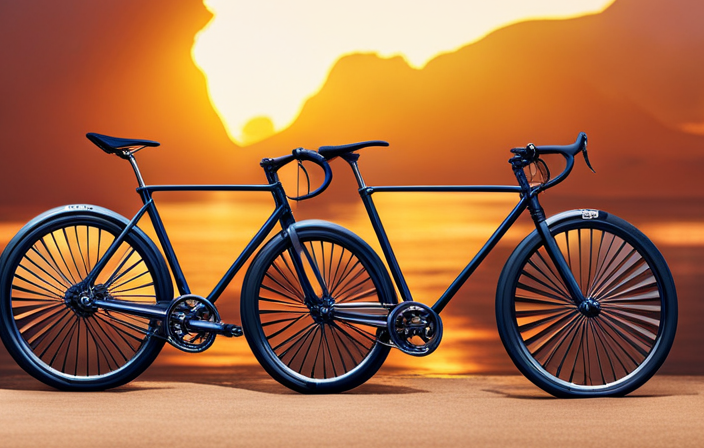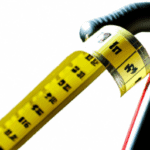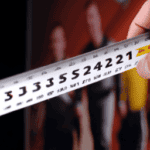Picture your bike as a well-oiled machine, where every part has a key role to play in perfect synchronization. The stem, acting as the essential link between your handlebars and frame, serves as the conductor, overseeing control and comfort.
But how do you know if your stem length is perfectly in tune with your body and riding style? In this article, I will guide you through the precise and detailed process of measuring your bicycle stem length, ensuring that your ride is not only efficient but also tailored to your individual preferences.
Key Takeaways
- Stem length is an important factor in achieving the optimal riding position.
- Experiment with different stem lengths to find the most natural and comfortable one.
- Consider bike handling and control while adjusting stem length.
- Regularly check and fine-tune stem length for optimal performance and comfort.
Understand the Importance of Stem Length
Understanding the importance of stem length is crucial when measuring a bicycle. The stem length plays a significant role in achieving the ideal bike fit, ensuring comfort, control, and optimal performance.
When choosing the right stem length, several factors should be considered. First, consider your riding style and preferences. A shorter stem provides quicker handling and more responsive steering, ideal for aggressive riding or technical trails. On the other hand, a longer stem offers increased stability and better weight distribution, suitable for long-distance rides or endurance cycling.
Additionally, your body proportions and flexibility play a role. A professional bike fitting can help determine the optimal stem length based on your measurements.
With the understanding of the importance of stem length, let’s now move on to gathering the necessary tools for measuring.
Gather the Necessary Tools
To get started, you’ll need a few tools for bike stem installation. Here is a table with the necessary tools:
| Tools | Purpose |
|---|---|
| Allen wrench | To loosen and tighten bolts |
| Tape measure | To measure the stem length |
| Torque wrench | To ensure proper bolt tightness |
| Grease | To lubricate the stem and bolts |
When measuring stem length, it’s important to avoid some common mistakes. First, make sure your bike is level and upright before taking measurements. Second, measure from the center of the handlebar clamp to the center of the steerer tube. Lastly, take note of any spacers or risers that may affect the stem length.
Once you have gathered the necessary tools and understand the importance of stem length, the next step is to remove the existing stem.
Remove the Existing Stem
First, you’ll need to take off the stem that is already on your bike. To remove the existing stem, there are a few techniques you can use.
One common method is to loosen the bolts on the stem with an Allen wrench or a socket wrench. Make sure to loosen them evenly, alternating between bolts, to prevent any damage.
Another technique is to tap the stem gently with a rubber mallet to loosen it from the steerer tube. However, be careful not to hit it too hard and damage the bike frame.
Common issues when removing bicycle stems include rusted or stripped bolts, which may require more force or special tools to remove.
Once you have successfully removed the stem, you can move on to measuring its length.
Measure the Current Stem Length
Next, you’ll need to determine the size of the existing stem on your bike. To measure the stem length, start by placing a ruler or tape measure at the center of the handlebar clamp and extend it towards the center of the steerer tube. Make sure to measure the stem length along the centerline.
Additionally, take note of the stem angle, which is the angle between the handlebar clamp and the steerer tube. This can affect the overall length of the stem.
Keep in mind that there are various factors that can influence the stem length, such as your body proportions, bike geometry, and riding style. These factors contribute to finding the optimal stem length for your comfort and performance.
Now, let’s consider your riding style and preference in the next section.
Consider Your Riding Style and Preference
Now, let’s think about your riding style and what you prefer. When it comes to measuring the bicycle stem length, it’s important to consider your riding style and personal preferences. The stem length can greatly affect your riding experience, so it’s crucial to choose the right length for you.
To help you understand the different factors to consider, I’ve created a table below:
| Riding Style Considerations | Personal Preference Factors |
|---|---|
| Aggressive riding style | Longer stem |
| Relaxed riding style | Shorter stem |
| Stability at high speeds | Longer stem |
| Maneuverability | Shorter stem |
By taking into account your riding style and personal preferences, you can determine the ideal stem length that suits you best. In the next section, we will delve into how to determine the ideal stem length without compromising on comfort and performance.
Determine the Ideal Stem Length
To determine the ideal stem length for your bike, it’s important to take into account your riding style and personal preferences. Here are the factors that affect stem length choice:
-
Reach: The stem length should allow you to comfortably reach the handlebars without straining your back or shoulders.
-
Bike handling: A shorter stem provides quicker and more responsive handling, while a longer stem offers stability and better control.
-
Body position: Consider your posture on the bike. A more upright position may require a shorter stem, while a more aggressive position may benefit from a longer stem.
-
Stem compatibility: Make sure the stem you choose is compatible with your bike’s handlebar clamp diameter and steerer tube diameter.
Considering these factors will help you determine the ideal stem length for your bike. Now, let’s move on to choosing the appropriate stem length for your bike.
Choose the Appropriate Stem Length for Your Bike
When selecting the right stem for your bike, consider factors such as your riding style, body position, and stem compatibility.
Choosing the appropriate stem length is crucial for achieving optimal comfort and performance on your bike. Your stem length affects your reach and overall riding position. To determine the ideal length, start by considering your riding style.
If you prefer a more aggressive, aerodynamic position, a shorter stem may be suitable. On the other hand, if you prefer a more upright and comfortable position, a longer stem may be preferable. Additionally, your body position plays a role in determining the right stem length. Factors such as your flexibility and arm length should be taken into account.
Lastly, ensure that the stem you choose is compatible with your bike’s steerer tube diameter and handlebar clamp diameter. Once you have chosen the appropriate stem length, you can move on to installing the new stem.
Install the New Stem
After choosing the appropriate stem length for your bike, it’s time to install the new stem. This step is crucial to ensure a comfortable and efficient riding position.
First, loosen the bolts on the steerer tube clamp using an Allen wrench, allowing you to slide the old stem off.
Next, align the new stem with the front wheel and handlebars, making sure it is straight before tightening the bolts. Remember to adjust the stem angle to your desired position, taking into consideration your riding style and comfort.
Once the stem is securely tightened, give it a gentle shake to ensure it is stable.
Now, you’re ready to test and adjust as needed, making any necessary changes to the stem length or angle to achieve the optimal riding experience.
Test and Adjust as Needed
Once you’ve installed the new stem, it’s important to test and make any necessary adjustments to achieve the optimal riding experience.
Start by adjusting the stem height to ensure it matches your preferred riding position. This can be done by loosening the stem bolts, raising or lowering the stem, and then tightening the bolts again.
Next, finding the right stem angle is crucial for comfort and control. Experiment with different angles by loosening the bolts and rotating the stem until you find the position that feels most natural to you.
Once you’ve made these adjustments, take your bike for a test ride to see how it feels. If it still doesn’t feel right, don’t hesitate to fine-tune the stem height and angle further.
By taking the time to test and adjust your new stem, you’ll be able to enjoy a more comfortable and efficient ride.
Enjoy a More Comfortable and Efficient Ride
To have a more comfortable and efficient ride, it’s essential to make adjustments to the stem height and angle until it feels natural to you. Here are some simple steps to help you enjoy a better biking experience:
- Experiment with different stem lengths and angles to find the optimal position for your body.
- Pay attention to your bike handling, as a well-adjusted stem can improve control and maneuverability.
Avoid discomfort and pain by ensuring that your stem height allows for a neutral riding position, with minimal strain on your neck and back.
Consider your riding style and preferences when adjusting the stem, as a more aggressive position may be suitable for speed and performance, while a more upright position may be better for comfort and leisurely rides.
Regularly check and fine-tune your stem adjustments as your riding needs and preferences change.
By making these adjustments, you can enhance your bike handling, prevent discomfort, and enjoy a more comfortable and efficient ride.
Frequently Asked Questions
How do I know if my current stem length is too long or too short?
If my stem is too long, it can cause discomfort and strain on my neck and shoulders. If it’s too short, I may feel cramped and have trouble controlling the bike. Proper body positioning is crucial, and a professional bike fitting can help determine the ideal stem length.
Can I use any type of measuring tool to determine the stem length?
Using any measuring tool may not give accurate results for determining stem length. It’s crucial to consider a variety of factors such as bike fit, riding style, and personal preference. Different types of stems can also affect the desired length.
What are the potential consequences of using an incorrect stem length?
Using an incorrect stem length on a bicycle can have potential consequences. It can lead to injuries such as back pain, numbness, and discomfort. It can also affect bike handling, making it less stable and responsive.
Are there any alternative methods to measure the stem length?
Alternative methods for accurately measuring bicycle stem length include using a stem length gauge or a ruler to measure the distance from the center of the handlebar clamp to the center of the steerer tube.
Can I adjust the stem length on my bike after it has been installed?
Yes, you can adjust the stem length on your bike after it has been installed. Adjustable stems offer the advantage of allowing you to customize the reach and height of your handlebars. To properly adjust the stem length, loosen the bolts, position the stem to your desired length, and then tighten the bolts securely.
Conclusion
In conclusion, measuring the bicycle stem length is a crucial step in ensuring a comfortable and efficient ride. By following the steps outlined in this article, you can easily determine the appropriate stem length for your bike.
However, some may argue that stem length is not a significant factor in overall bike performance. While it may not be the only factor, it does play a vital role in rider comfort and handling.
Taking the time to measure and choose the right stem length will greatly enhance your cycling experience.
















